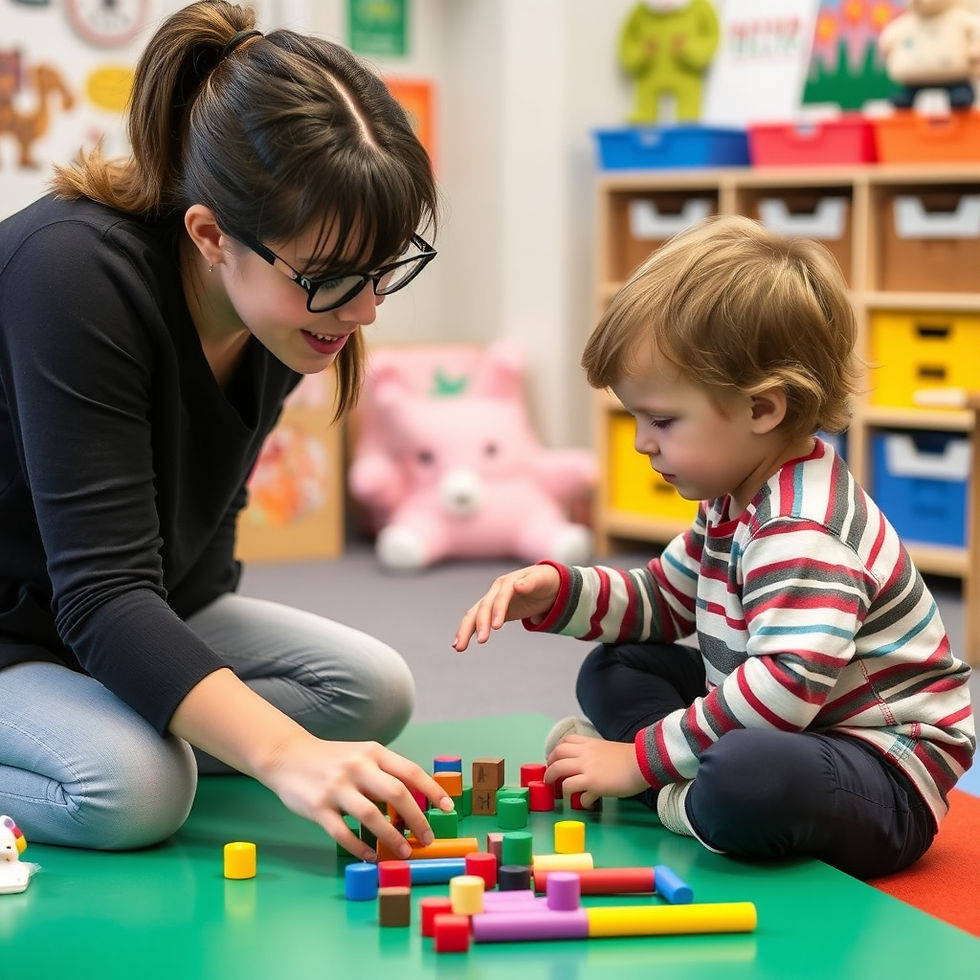Why I had a strong focus on Play in a classroom of autistic students.
- Rosalie Markovics

- Oct 20, 2015
- 5 min read
Updated: Sep 3

Play Skills for Autistic children: Imagination, Social Skills, Communication Skills.
When I first started to teach autistic students, the first thing I noticed was their inability to play and use their leisure time constructively. It was not uncommon, in a new class with first year students, to see a child leaning up against the wall and he needed intervention to use his time constructively.We always had toy shelves but the toys would sit there, if the students were unfamiliar with the toys, or a child would use the same toy over and over again, in a repetitious manner (this is where repetition is not a good thing and the children need to be moved on in their skills.)
It is of utmost importance to teach play skills to the autistic child as it is the most natural and effective medium to develop social skills, imagination and communication skills. To play is a natural thing for most children so it is therefore a priority to give autistic children the same opportunities that other chldren have to develop skills and be happy. The alternative maybe: loneliness and the feeling of living on the outside of groups, and difficulty forming friendships.

As I personally feel that Play skills are so important, I will write a series of posts and give each post a focus.
In my class timetable, I always endeavoured to have at least 3 sessions a week. Sometimes, I tagged a short play session on the end of another session, such as music.
Basically, they came under the headings of Indoor Play, Outdoor Games, and Table Games.
Indoor Games to Autistic Students- Let's have a Party!
Going to parties is part of childhood so all the teachers endeavoured to teach the autistic students how to behave appropriately at a birthday party, and some typical party games.

The students would be told the day before that someone in the class was having a birthday and we would be celebrating it the next day. A visual would be shown to make sure all students understood.
A picture would be placed on the schedule board, showing the time of the day for the party.
All children could be involved in the table display, making a banner, getting table ware but it is good to keep an eye on the food and store it in a safe place!
And the party begins!
Most teachers had a party box and the child could choose which party hat the student wanted to wear and give some hats out to others. The birthday child could dress up with anything they found in the box.
The child could choose a list of games, or the order they could be played in and put it on a schedule board.
Some Games To Teach to Students with Autism:
Pass the Parcel. This can be quite difficult for some children as they have to wait and some children will try to keep the parcel and take out all the contents. These children will require some adult support, such as manual help passing to the next child. It is always an idea to give the parcel to the most anxious child first, and so on(although, generally the birthday child had first go). The children would put their parcel under the chair until the game had finished.
Pin the Tail: Sometimes, we would draw something rather than have a store bought display. This is quite funny with autistic students as they find the blindfold funny but some require assistance as they lose their sense of direction when they are blindfolded. Some students would peek or not tolerate a blindfold, and we turned a blind eye to that.

Musical chairs: If the children were very young,I would start teaching them a different version then work their understanding and tolerance up to playing it the way they would play it at parties. Most of the children I had taught had never been to a party before, apart from a few who had family parties.
So my version was simple: the first time around, all chairs would remain and so all children practised finding a chair. Some students may require adult assistance with the walking and finding a chair when the music has stopped.
Then, I would only remove one chair and the game would start again. I would change the position of the 'empty' chair but only ever had one chair missing.
When I felt that all students understood the game, and would not get too anxious, we would play it the other way. I would tell them it would be different that day and show and demonstrate that they would have to sit on the chairs until the game had finished.
Some teachers liked to teach it with all chairs being taken out and that is your call as a teacher. I like to break things down and focus on one thing at a time so my method worked well for me as I felt the students only had to focus on one thing at a time, before moving them on to the full expectation.
Statues This is always fun for autistic students and they generally do it well. Once again, some students may require physical assistance.
Indoor Bowls: This game may need regular practise and students may have different starting positions, depending on their skills. They will need markers to help them with setting up the pins.
Poison Ball with a soft ball can also be played inside.
Balloon Races-they always enjoyed races with a balloon between their knees.
Balloon Challenge- slip a piece of paper into each balloon before you blow it up. As each child pops their balloon, they take out the challenge. Down scale it for autistic students e.g. do ten jumps.
The Birdie Dance - all children are familiar with this dance and most enjoy it.
Usually, there was only time for 3 games and then we sat at the party table and had our party food.
Always make sure of dietary restrictions and we would not allow any food that a child was allergic to. The birthday student would offer the goodies around the table and children could also make requests and put them on their plates. Make sure you have pictures on the table for the non-verbal children, or parts of packaging will do also for requesting, if you do not have a picture of an item. After a while, I would allow the student to reach over to get something but I wanted to discourage the grabbing at food that some children did, and also the putting back of food that they had bitten into, and did not like. These are all social skills to watch out for and try to teach in a positive manner.
We would get positive feedback from the parents as to their child's participation at parties so it was a worthwhile focus. There are also different versions of Happy Birthday and I would play one version in the morning at Morning Schedule and a different version in the afternoon, when the birthday cake and candles were there.
These simple games were embedded into a birthday party scenario and had the vital skills of play, communication, and social skills embedded in the lesson.
Think outside the square to give your child exposure to activities that will increase confidence, communication, and leisure skills to enjoy life.
Recommended games:
For young children, these games are highly recommended Mad Dragon - An Anger Control Card Game
For children and teens The Tower of Self Esteem Game, School Counselor & Therapist Tools for Social Skills & Emotion Regulation, Builds Confidence & Bonding
*As an Amazon affiliate, I earn from qualifying purchases
To see all my posts, you can return to my Home Page here.
Still to come: Indoor games-Table Games-Floortime Play Therapy-1:1 sessions.
Don't forget to like my pages on FB, Twitter, or G+ and Twitter and share my blog with your friends.






















Comments